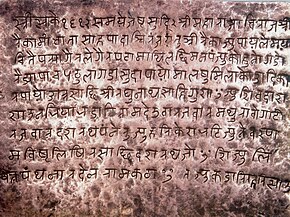Khas Kura
| Khasa Prakrit | |
|---|---|
| खश, खष, खशीर | |
 Copper Inscription by Baise King of Doti, Raika Mandhata Shahi at Saka Era 1612 (शाके १६१२) (or 1747 Bikram Samvat),(= AD 1690 or 1691) in old Khas language using Devanagari script | |
| Native to | Khasa Kingdom |
| Region | Indian subcontinent |
| Ethnicity | Khasas |
Indo-European
| |
| Language codes | |
| ISO 639-3 | – |
| Glottolog | None |
Khasa Prakrit (also known as Khas Prakrit, Sanskrit Khasa, Himalayan Prakrit, Northern Prakrit, Khas Kura) is a Prakrit language of medieval South Asia and a common ancestor language of the Pahari languages, which includes Nepali, Kumaoni, Jaunsari, Mandeali, Kangri and Garhwali languages.[1][2] It was commonly referred to as खश (Khaśa), खष (Khaṣa), and खशीर (khaśīra) in the Sanskrit texts.
Indian linguist Suniti Kumar Chatterji suggests that Nepali language developed from Khasa Prakrit.[3] Khas Prakrit is named after the speakers of language, Khas people, who live in the Himalayas.[4]
History
Origin and development
Khasa belongs to the Indo-European family of languages. Like other Indo-Aryan languages, Khasa is a direct descendant of an early form of Vedic Sanskrit, through Shauraseni Prakrit and Śauraseni Apabhraṃśa (from Sanskrit apabhraṃśa "corrupt").[5]
Language comparison
| Nepali | Kumauni | Kashmiri | ||||
|---|---|---|---|---|---|---|
| Masc | Fem | Masc | Fem | Masc | Fem | |
| I am | chu | chu | chic | chu | thus | ches |
| You are | chas | ches | chai | chi | chukh | chekh |
| He is | cha | che | ch | chi | chuh | cheh |
See also
References
- ^ Pradhan, Kumar (1991). The Gorkha Conquests: The Process and Consequences of the Unification of Nepal, with Particular Reference to Eastern Nepal. Oxford University Press. pp. 30–40. ISBN 978-0-19-562723-7.
- ^ Schmidt, Ruth Laila (1993). व्यावहारिक नेपाली-अङ्ग्रेजी शब्दकोश. Ratna Sagar. pp. ix. ISBN 978-81-7070-172-9.
- ^ Subba, Tanka Bahadur (2009). Indian Nepalis: Issues and Perspectives. Concept Publishing Company. pp. 325–337. ISBN 978-81-8069-446-2.
- ^ Ray, Dinesh Chandra; Chowdhury, Srikanta Roy (2022-12-22). Darjeeling: In Search of People's History of the Hills. Taylor & Francis. ISBN 978-1-000-82880-1.
- ^ "नेपाली भाषाको उत्पत्ति र विकास" (PDF). Uttarakhand Open University (in Nepali). Retrieved 19 February 2024.